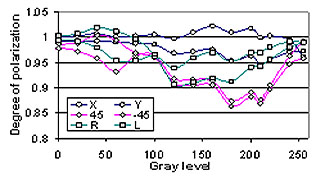Characterization and Optimization of a LCoS Liquid Crystal Display

This type of study is especially relevant since all those previously mentioned applications of SLM require a precise control of the amplitude and phase modulation properties of the display. Previous methods to achieve such a precise control are based on the use of the Jones matrix formalism, which ignores depolarization effects. For that reason, it has been developed this method for the characterization and optimization of the light intensity modulation achieved with a LCoS display. The method used the M-S matrix formalism, and therefore can be used for completely polarized light, as well as for partially polarized light, even for completely unpolarized light.
The Mueller matrix characterizing the display relates the input state of polarization (SOP) with the output SOP emerging form the device. It has been designed an optical setup in order to generate arbitrary SOP on the input beam, and detect arbitrary SOP on the reflected beam. By taking intensity measurements at different polarization configurations at the input and reflected beams (typically lineal polarization oriented at the X axis, at Y axis, or at +/-45º, and circular polarization types R and L), the coefficients of the Mueller matrix describing the display can be derived. In this way, a experimental Mueller matrix is obtained for each gray level addressed to the display, and the degree of polarization (DoP) can be measured. They observed values of DoP that depend both on the input SOP and on the addressed gray level (see Fig.1), reaching values of depolarization greater than 10% (DoP<90%). This justifies the use of the M-S formalism instead of the Jones formalism.
Fig. 2. LCoS intensity and phase response in: (top photo) Maximum intensity contrast configuration; (bottom photo) Phase-only configuration (constant intensity).
As a result of the calibration, it has been able to predict and optimize the optical response of the LCoS display. For that purpose we have developed a specific software which, based on an optimization criteria, leads to the appropriate SOP configuration and the input and reflected beams. Following this method it has been found excellent results in order to operate the display as a intensity modulator with very high contrast (Fig. 2(a)), or as a phase-only modulator, where the intensity remains constant with the addressed gray level, and a large phase modulation is simultaneously produced (Fig. 2(b)). Phase modulation has been measured by means of an interferometric method. In both curves, the red line denotes the theoretical intensity predicted as a function of the gray level, while the dots represent the experimental values; an excellent agreement is obtained. Additionally, blue points denote the experimental phase modulation as a function of the gray level.
References
A. Márquez, I. Moreno, C. Iemmi, A. Lizana, J. Campos, M. J. Yzuel, "Mueller-Stokes characterization and optimization of a liquid crystal on silicon display showing depolarization", Optics Express, Vol. 16 3, 1669-1685 (2008).


